Spaying / Neutering
(article ref:- http://www.americanhumane.org/animals/adoption-pet-care/caring-for-your-pet/spaying-neutering.html and http://www.lbah.com/canine/dog_neuter.html)
Spaying is a general term used to describe the ovariohysterectomy of a female animal. Neutering is a general term used to describe the castration of a male animal. However, neutering is often used in reference to both genders. The surgical procedure, performed by a veterinarian, renders the animal incapable of reproducing. Here are answers to some questions you may have about this beneficial procedure.
When can I have this procedure done?
Both procedures can safely be performed at as early as 8 weeks of age. American Humane Association is a strong proponent of juvenile or pediatric spay/neuter since it is both healthy for pets and effectively reduces pet overpopulation.
Why should I have my pet neutered?
Animal shelters, both public and private, are faced with an incredible burden: What to do with the overpopulation of dogs and cats that they cannot find homes for? Approximately 3.7 million animals are euthanized at shelters each year, due to the sheer fact that there are not enough willing adopters. Having your pet spayed or neutered ensures that you will not be adding to this tremendous burden.
What are some of the health and behavioral benefits?
Through neutering, you can help your dog or cat live a happier, healthier, longer life. Spaying eliminates the constant crying and nervous pacing of a female cat in heat. Spaying a female dog also eliminates the messiness associated with the heat cycle.
Neutering of male dogs and cats can prevent certain undesirable sexual behaviors, such as urine marking, humping, male aggression and the urge to roam. If you have more than one pet in your household, all the pets will generally get along better if they are neutered.
A long-term benefit of spaying and neutering is improved health for both cats and dogs. Spaying females prior to their first heat cycle nearly eliminates the risk of breast cancer and totally prevents uterine infections and uterine cancer. Neutering males prevents testicular cancer and enlargement of the prostate gland, and greatly reduces their risk for perianal tumors.
Isn't it wrong to deprive an animal of the natural right to reproduce?
No, it’s wrong to allow these animals to reproduce millions of unwanted offspring that are eventually killed because there aren’t enough responsible homes.
If I find homes for my pet's litters, then I won't contribute to the problem, right?
Wrong. Only a finite number of people want pets. So every home you find for your pet’s offspring takes away a home from a loving animal already at a shelter.
Shouldn't every female pet have at least one litter before being spayed?
No. In fact, your pet will be healthier if she never sexually matures.
Shouldn't children experience the miracle of birth?
No. A more important lesson to teach your children would be responsible pet ownership and concern for life by explaining why their pet should not have babies.
Doesn't neutering alter an animal's personality?
No. Personality changes that may result from neutering are for the better. Not being distracted by the instinctual need to find a mate helps your pet stop roaming and decreases aggressive tendencies.
Won't animal shelters take care of the surplus animals?
No. Shelters do their best to place animals in loving homes, but the number of homeless animals far exceeds the number of willing adopters. This leaves many loving and healthy animals in our community that must be euthanized as the only humane solution to this tragic dilemma. Only spaying and neutering can end the overpopulation problem.
Surgery
This page shows the surgical procedures...
The following area contains graphic pictures of an actual surgical procedure performed at the hospital.
 The dog being neutered in this picture has only one testicle in the scrotum, called a cryptorchid or retained testicle. This happens in only a small percentage of the animals we neuter. The other testicle can be in the abdomen or in the inguinal canal (inner thigh region). In this dog's case it is in the inguinal canal, as evidenced by the bulge (arrow). It is important to remove the retained testicle because it can become cancerous later in life.
The dog being neutered in this picture has only one testicle in the scrotum, called a cryptorchid or retained testicle. This happens in only a small percentage of the animals we neuter. The other testicle can be in the abdomen or in the inguinal canal (inner thigh region). In this dog's case it is in the inguinal canal, as evidenced by the bulge (arrow). It is important to remove the retained testicle because it can become cancerous later in life.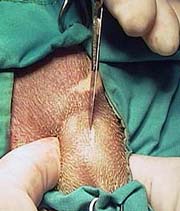 First we will remove the normal testicle without the laser. The procedure begins with an incision in the skin. We prefer to make our incision in front of the scrotum and not actually on the scrotum. This tends to minimize post operative licking and aids the healing process.
First we will remove the normal testicle without the laser. The procedure begins with an incision in the skin. We prefer to make our incision in front of the scrotum and not actually on the scrotum. This tends to minimize post operative licking and aids the healing process.The testicle is gently squeezed forward and the incision over the testicle is made just big enough to gently squeeze it out. Smaller incisions heal faster, require less anesthetic time and there is less chance for complications.
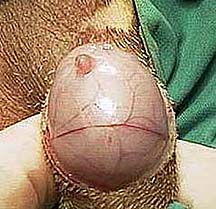 The testicle bulges out of the incision cover by its internal layers called tunics. These tunics are carefully incised to expose the testicle and all its associated structures. In the picture on the right you can see 3 main testicular structures now that the covering is off. The vertically running dark blood vessels on the left are called the pampiniform plexus. They are a group of blood vessels that supply nutrients to the testicle, keep the testicle at an optimum temperature for viable spermatozoa, and distribute testosteron from the testicle into the general bloodstream. The structure just to the right of the pampiniform plexus, and partially surrounding the testicle, is the epididymus, the storage area of spermatozoa already produced by the testicle. The round structure to the right is the testicle itself.
The testicle bulges out of the incision cover by its internal layers called tunics. These tunics are carefully incised to expose the testicle and all its associated structures. In the picture on the right you can see 3 main testicular structures now that the covering is off. The vertically running dark blood vessels on the left are called the pampiniform plexus. They are a group of blood vessels that supply nutrients to the testicle, keep the testicle at an optimum temperature for viable spermatozoa, and distribute testosteron from the testicle into the general bloodstream. The structure just to the right of the pampiniform plexus, and partially surrounding the testicle, is the epididymus, the storage area of spermatozoa already produced by the testicle. The round structure to the right is the testicle itself.The blood supply to the testicle is brought out and two sutures are placed around it. After the testicle is cut the sutured tissue is placed back through the incision.
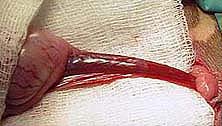 | 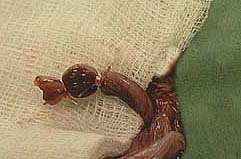 |
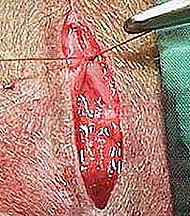 Two layers of sutures are used to close the incision. The first is called the subcutaneous layer, because it is the layer of tissue under the skin. Sealing this layer gives an added margin of safety, especially if the dog licks the area excessively.
Two layers of sutures are used to close the incision. The first is called the subcutaneous layer, because it is the layer of tissue under the skin. Sealing this layer gives an added margin of safety, especially if the dog licks the area excessively.The skin layer is frequently closed in a suture pattern called subcuticular.
This layer is the underside of the skin. This technique gives a cosmetic appearance and makes it difficult for a dog to chew its stitches out.

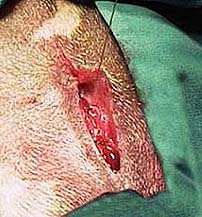
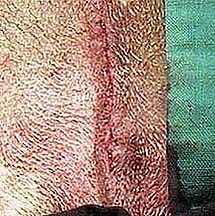
Hello Everyone
ReplyDeleteAny one of you might be thinking of adopting a puppy well before that you should really consider The health of the puppy you are going to adopt should be on top of your concern. Make sure that you take your adopted puppy to a doctor and check the health status of it.For more information take a look at-puppies for Adoption
Thanks